Lessico
Malva
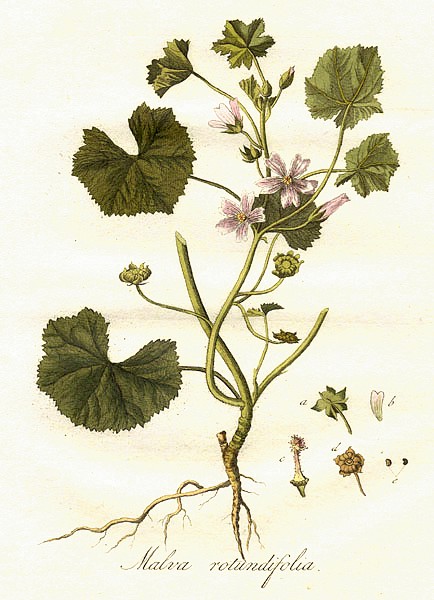
Malva
è un genere di piante della famiglia Malvacee con una trentina di specie
proprie dell'Africa settentrionale e dell'Eurasia, alcune delle quali vivono
spontanee anche in Italia. Fra queste le più comuni sono Malva sylvestris
(malva comune) e Malva rotundifolia, dei luoghi erbosi e degli incolti.
Dalle foglie e dai fiori si ottiene un infuso con proprietà emollienti ed
espettoranti. Alcune specie sono anche coltivate per ornamento. Alla famiglia
delle Malvacee appartiene anche il genere Althaea![]() dotato delle stesse caratteristiche farmacologiche.
dotato delle stesse caratteristiche farmacologiche.
Altea![]() era la madre di Meleagro. Costui, fatto perire dalla madre, grazie alle lacrime delle sorelle diede il nome alla gallina faraona, Numida
meleagris
era la madre di Meleagro. Costui, fatto perire dalla madre, grazie alle lacrime delle sorelle diede il nome alla gallina faraona, Numida
meleagris![]() . La
leggenda vuole che le sorelle di Meleagro, avvinghiate alla lapide a
piangere la morte dello sfortunato fratello, furono trasformate da Artemide
. La
leggenda vuole che le sorelle di Meleagro, avvinghiate alla lapide a
piangere la morte dello sfortunato fratello, furono trasformate da Artemide![]() - o Diana
- in uccelli, in faraone. Le macchioline bianche sul piumaggio, altrimenti
uniformemente nero, furono il marchio indelebile delle lacrime versate dalle fanciulle per
l’amato fratello.
- o Diana
- in uccelli, in faraone. Le macchioline bianche sul piumaggio, altrimenti
uniformemente nero, furono il marchio indelebile delle lacrime versate dalle fanciulle per
l’amato fratello.
Malva
sylvestris
Common Mallow
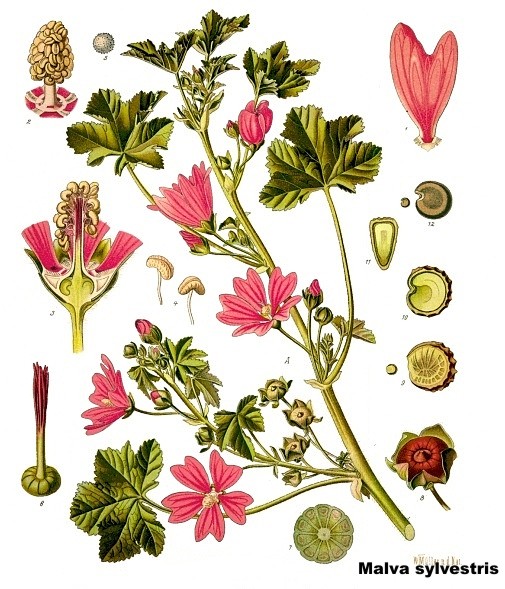
Malva sylvestris (Common Mallow) is a species of Malva native to Europe (the British Isles and Iberia north to southern Scandinavia and east to Russia and the Caucasus), northern Africa (Morocco east to Egypt), and Asia (western and southwestern Asia, central Asia east to Kyrgyzstan, and east along the Himalaya to Bhutan).
It is a herbaceous annual, biennial, or perennial plant growing to 1–1.5 m (rarely 3 m) tall, with hairy stems and foliage. The leaves are alternate, palmately lobed, 2-10 cm long and 2-10 cm broad with three to seven shallow, rounded lobes and a serrated margin. The flowers are produced in clusters of two to six in the leaf axils, each flower 2–5 cm diameter, with five dark pink to purplish petals with a notch at the apex. The fruit is a disc-shaped schizocarp 5–8 mm diameter, containing 10–12 seeds, the seeds individually enclosed in a usually glabrous (occasionally hairy) mericarp. It has a chromosome count of 2n=42.
Plants with hairy seed mericarps have sometimes been distinguished as Malva sylvestris var. lasiocarpa Druce, and small plants from high altitude in the Atlas Mountains have sometimes been distinguished as Malva sylvestris subsp. subacaulis Maire, though neither is widely regarded as distinct.
It occurs on dry, well-drained soils at altitudes from sea level up to 1,800 m in northern Europe and to 3,000 m in northwest Africa, growing on open, sunny sites with little competition from other plants. The flowers are usually pollinated by bees.
It is often grown as an ornamental plant for its attractive flowers, produced for a long period through the summer. Numerous cultivars have been selected and named. Plants previously often described as Malva sylvestris var. mauritiana are now considered a Cultivar Group Malva sylvestris Mauritiana Group.
Like other species of the genus Malva, it is high in mucilage content. It was historically used medicinally, internally as a demulcent using a seed extract or boiled young leaves, and externally as an emollients, for which it is still in some use as a natural skin treatment.
The species has long been used as a natural dye, and the French name of the species mauve was used for the English name of the first synthetic dye of similar colour, better known as mauveine, which lead to the word mauve as an English colour name. It has been introduced to and become naturalised in eastern Australia and North America.
Other names sometimes used in cultivation included high mallow, tall mallow, wood mallow, wild mallow, cheese-flower, cheese-cake, pick-cheese, round dock, maul, and country-mallow. It is one of several species of different genera sometimes referred to as creeping charlie, a term more commonly applied to Glechoma hederacea (ground ivy).
Malva
sylvestris
Grande mauve
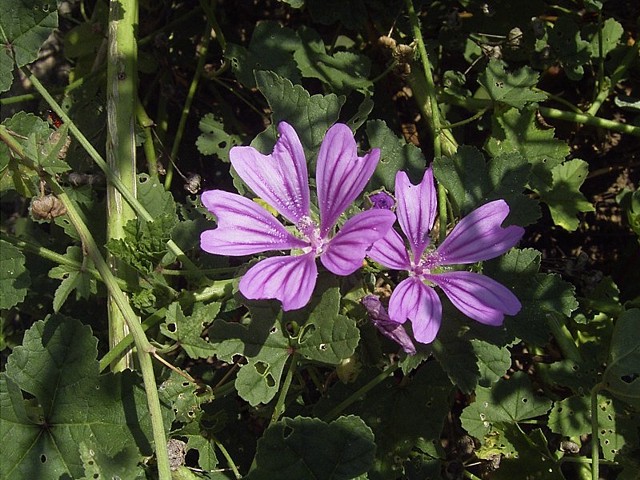
La grande mauve, appelée
aussi mauve sylvestre ou mauve des bois, (Malva sylvestris) est une
plante herbacée bisannuelle de la famille des Malvacées.
C'est une plante vivace poilue, aux tiges souvent étalées, de 30 à 60 cm,
aux feuilles crénelées , ressemblant un peu à celles du lierre, aux fleurs
rose-pourpre avec des nervures plus foncées sur les pétales.
Cette mauve était appelée autrefois, en latin, omnimorbia soit toutes les maladies, en raison de ses propriétés adoucissantes pour les voies respiratoires utiles pour le traitement de nombre de symptômes. La substance active recherchée dans cette plante est le mucilage.
Les principaux effets de la mauve sont émollient et désinfectant. On s'utilise pour apaiser toux, maux de gorge, aphtes, bronchite, enrouement, et laryngite.
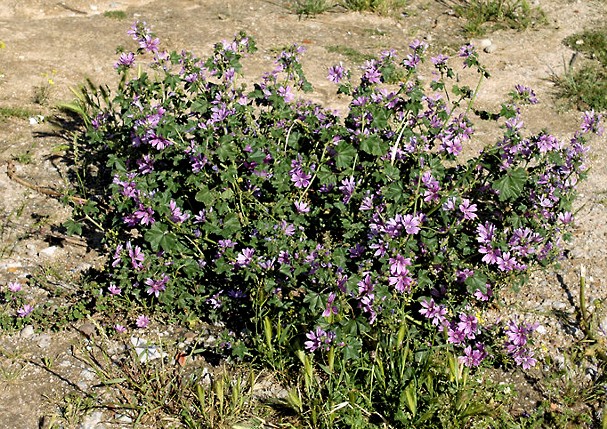
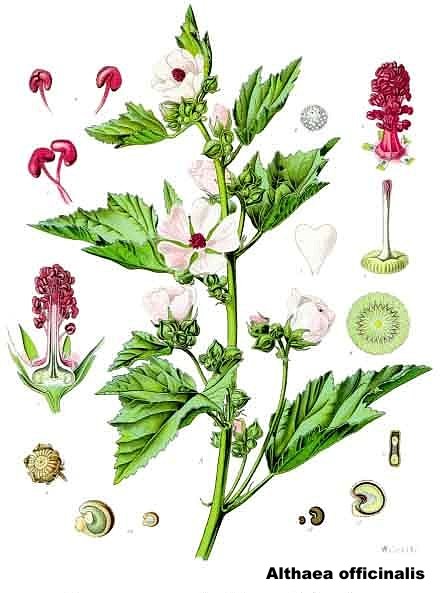
Il genere Althaea appartiene alla famiglia delle Malvacee. Althaea deriva dal greco althaía, a sua volta dal verbo althaínø = guarire.
Althaea officinalis: pianta erbacea perenne spontanea nei luoghi umidi delle zone temperate d'Europa, Asia e Africa boreale. Alta fino a 150 cm, ha radici carnose, a fittone; foglie alterne, le inferiori cordato-subrotonde, le altre ovali, lobate o divise, coperte di peli; fiori ampi caliciformi bianchi, rosati o porporini, in grappoli terminali; frutto orbicolare formato da carpelli (cocche) separantisi a maturità. Tutte le parti dell'altea sono ricche di mucillagine ad azione emolliente ed espettorante.
Proprietà analoghe ha la radice di Althaea rosea, coltivata a scopo ornamentale per i suoi fiori variamente colorati dal bianco al viola. Altra specie è l'Althaea cannabina, dai fiori rosei, spontanea nei luoghi incolti.
Althaea
Althaea is a genus of 6-12 species of perennial herbs, including the marshmallow plant whence the confection got its name, native to Europe and western Asia. They are found on the banks of rivers and in salt marshes, preferring moist, sandy soils. The stems grow to 1-2 m tall, and flower in mid summer. The leaves are palmately lobed with 3-7 lobes. Althaea species are used as food plants by the larvae of some Lepidoptera species including Bucculatrix quadrigemina. The genus formerly included a number of additional species now treated in the genus Alcea (Hollyhocks).
The root contains starch (37%), mucilage (11%), pectin (11%), flavonoids, phenolic acids, sucrose, and asparagine. In herbalism mallow is used as a gargle to treat mouth and throat ulcers. It is also useful for gastric ulcers. The flowers and young leaves can be eaten. They are often added to salads or boiled and fried. They are also used in cosmetics for the skin.
The root has been used since Egyptian antiquity in a honey-sweetened confection useful in the treatment of sore throat. The later French version of the recipe, called pâte de guimauve, included an eggwhite meringue and was often flavored with rose water. Pâte de guimauve more closely resembles contemporary commercially available marshmallows, which ironically no longer contain any actual marshmallow.
The root's emulsifying property is used for cleaning Persian carpets in the Middle East. It is regarded as the best method to preserve the vibrancy of vegetable dyes used in coloring the carpet's wool.
Althaea
officinalis
Marshmallow
Althaea officinalis (Marshmallow, Marsh Mallow, or Common Marshmallow) is a species native to Africa, which is used as a medicinal plant and ornamental plant.
The stems, which die down in the autumn, are erect, 3 to 4 feet high, simple, or putting out only a few lateral branches. The leaves, shortly petioled, are roundish, ovate-cordate, 2 to 3 inches long, and about 1 1/4 inch broad, entire or three to five lobed, irregularly toothed at the margin, and thick. They are soft and velvety on both sides, due to a dense covering of stellate hairs. The flowers are shaped like those of the common Mallow, but are smaller and of a pale colour, and are either axillary, or in panicles, more often the latter.
The stamens are united into a tube, the anthers, kidney-shaped and one-celled. The flowers are in bloom during August and September, and are followed, as in other species of this order, by the flat, round fruit called popularly 'cheeses.'
The
common Mallow is frequently called by country people, 'Marsh Mallow,' but the
true Marsh Mallow is distinguished from all the other Mallows growing in Great
Britain, by the numerous divisions of the outer calyx (six to nine cleft), by
the hoary down which thickly clothes the stems, and foliage, and by the
numerous panicles of blush-coloured flowers, paler than the Common Mallow. The
roots are perennial, thick, long and tapering, very tough and pliant, whitish
yellow outside, white and fibrous within. The whole plant, particularly the
root, abounds with a mild mucilage, which is emollient to a much greater
degree than the common Mallow. The generic name, Althaea, is derived
from the Greek, althaínø (to recover), from its healing properties.
Most of the Mallows have been used as food, and are mentioned by early classic
writers in this connexion. Mallow was an esculent vegetable among the Romans;
a dish of Marsh Mallow was one of their delicacies. The Chinese use some sort
of Mallow in their food, and Prosper Alpinus![]() stated
in 1592 that a plant of the Mallow kind was eaten by the Egyptians. Many of
the poorer inhabitants of Syria - especially the Fellahs, Greeks and Armenians
- subsist for weeks on herbs, of which Marsh Mallow is one of the most common.
When boiled first and fried with onions and butter, the roots are said to form
a palatable dish, and in times of scarcity consequent upon the failure of the
crops, this plant, which fortunately grows there in great abundance, is much
collected for food.
stated
in 1592 that a plant of the Mallow kind was eaten by the Egyptians. Many of
the poorer inhabitants of Syria - especially the Fellahs, Greeks and Armenians
- subsist for weeks on herbs, of which Marsh Mallow is one of the most common.
When boiled first and fried with onions and butter, the roots are said to form
a palatable dish, and in times of scarcity consequent upon the failure of the
crops, this plant, which fortunately grows there in great abundance, is much
collected for food.
The leaves, flowers and the root of Athaea officinalis (marshmallow) all have medicinal properties. The leaves, which are collected in summer as the plant begins to flower, have demulcent, expectorant, diuretic, and emollient properties. It is generally used in ailments of the lungs and the urinary systems, specifically in urethritis and kidney stones. The root, which is harvested in late autumn, has demulcent, diuretic, emollient, and vulnerary properties. It is generally used for digestive and skin problems, specifically inflammations of the mouth, gastritis, peptic ulcer, enteritis, and colitis. It increases the flow of breast milk and soothes the bronchial tubes. It has been used to treat constipation as well as irritable bowel syndrome. Externally the root is used in treating varicose veins, ulcers, abscesses, and boils. The root extract (halawa extract) is sometimes used as flavouring in the making of a middle eastern snack called halva.
History and folklore
Theophrastus![]() reported that it was taken in sweet wine for coughs.
reported that it was taken in sweet wine for coughs.
The
Greek physician Hippocrates![]() described the value of althea in the treatment of wounds.
described the value of althea in the treatment of wounds.
Dioscorides![]() ,
another Greek physician, prescribed a vinegar infusion as a cure for
toothaches and recommended a preparation of the seeds to soothe insect stings.
,
another Greek physician, prescribed a vinegar infusion as a cure for
toothaches and recommended a preparation of the seeds to soothe insect stings.
The
Roman poet Horace![]() ,
claimed the root and leaves had laxative properties.
,
claimed the root and leaves had laxative properties.
"Whosoever
shall take a spoonful of the Mallows shall that day be free from all diseases
that may come to him." — Pliny the Elder![]()
Renaissance period herbalists used althea for sore throats, stomach problems, gonorrhea, leukorrhea, and as a gargle for infections of the mouth.
In medieval times if a person was accused of something, to prove innocence the accused had to hold a red-hot iron bar. He/she was considered innocent if the person suffered no serious burns. Accounts from the Middle Ages state that anointing the palms with an ointment made from marshmallow would allow the accused, innocent or guilty, to remain unburned.
The common name Mortification Plant records the use of althea for treating wounds.
Use a mallow ointment to protect against evil and cast out demons.
Marshmallow crème derives its name from the edible use of the plants.
Mallows are cited in the
book of Job![]() in the Bible as used in
times of famine by the Egyptians.
in the Bible as used in
times of famine by the Egyptians.
Root of marshmallow used to create the sweet marshmallow candies.

Altea
di Johann Wilhelm Baur - 1659
miniaturista e incisore alsaziano (Strasburgo ca. 1600 - Vienna 1640)
Altea era la sposa di Eneo re di
Calidone in Etolia e madre di Deianira e Meleagro![]() . Altea, infuriata contro il
figlio che le aveva ucciso i due fratelli, assetata di vendetta gettò nel fuoco il tizzone da cui dipendeva la vita di Meleagro e
lo fece incenerire, provocando così la morte del figlio. Per il rimorso si suicidò
impiccandosi, oppure con un colpo di pugnale al petto.
. Altea, infuriata contro il
figlio che le aveva ucciso i due fratelli, assetata di vendetta gettò nel fuoco il tizzone da cui dipendeva la vita di Meleagro e
lo fece incenerire, provocando così la morte del figlio. Per il rimorso si suicidò
impiccandosi, oppure con un colpo di pugnale al petto.
Il nome Altea - che in greco
suona Althaía come la malvacea, a sua volta dal verbo althaínø =
guarire - per quanto concerne la sorte di Meleagro sembra nettamente in
antitesi col guarire. Forse si adatta meglio al fatto che col suicidio Altea
guarì per sempre se stessa dal suo insanabile rimorso. Insomma: era una
guaritrice predestinata, così come Alettrione![]() era un gallo predestinato.
era un gallo predestinato.